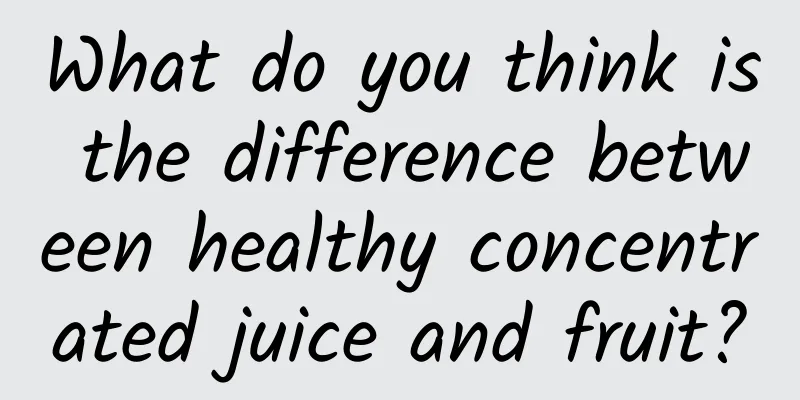What do you think is the difference between healthy concentrated juice and fruit?

|
Many places have entered summer early this year. In the face of increasingly hot weather, a glass of iced drink can always make people feel more relaxed! But experts say: drinking too much beverage is unhealthy! The dazzling array of 100% fruit juices in supermarkets, with only water and concentrated juice as ingredients, can be drunk, right? After all, concentrated juice is the essence, and the vitamin content must be richer! But is this really the case? Let's unveil the mystery of juice together. 01 Concentrate and fresh squeeze: the magical transformation of the fruit world Concentrated juice, as the name implies, is juice squeezed from fruits and then evaporated using low-temperature vacuum concentration technology to reduce its volume and increase its concentration. Therefore, when making and selling it, it is necessary to add a basic amount of water that has evaporated to restore it to the original juice concentration. Image source: e-commerce platform It sounds like this "100% juice" seems to have "concentrated" nutrients, but this is not the case. Concentrated juice is generally used as a food ingredient, and some volatile nutrients may be lost during the concentration process. Compared with whole fruits, the content of dietary fiber in juice is very low, and the content of vitamins, potassium and other minerals is not high, and the taste is slightly reduced. There are also some fruit juice drinks sold as “100% juice”, but the ingredient lists contain a wide variety of ingredients, which are “juice assassins” that we need to be wary of. Image source: e-commerce platform What is more popular on the market now is bottled freshly squeezed juice, also known as NFC (NFC is the abbreviation of "not from concentrate") juice. It is juice directly squeezed from fresh fruits as raw materials, and is cold-canned products that are sterilized by ultra-high pressure in an instant, which can retain the original fresh flavor of the fruit to the greatest extent. The price is also relatively high. In addition, there are freshly squeezed fruit juices that are often sold at night markets and stalls. Although the fruit juice is squeezed visible to the naked eye, the hygiene and safety of the raw materials and machines are also cause for concern, especially in hot seasons. If you are not careful, E. coli, Salmonella, etc. will multiply in large numbers. 02 Juice is not as perfect as you think Since both are processed fruits, why is there such a big difference between the two? It all starts with sugar. (1) Drinking fruit juice can easily lead to more sugar intake The sugar in the fruit can only be released through chewing and gastrointestinal digestion, which is slow and not easy to cause blood sugar fluctuations. After the fruit is squeezed, the cell wall of the fruit is broken, and more sugar will be released from the cell wall and become free sugar. The free sugar content of a cup of juice can reach 20-40 grams! After a few sips of juice, blood sugar will soar unknowingly, and the risk of chronic diseases such as obesity and diabetes will increase. The Chinese Nutrition Society recommends that the daily intake of free sugars should not exceed 25 grams. (2) Juice has a large nutritional loss After the fruit is squeezed into the juice, the cell structure is destroyed and the influx of oxygen can cause the oxidation of vitamin C and plant active substances such as flavonoids, thereby causing the loss of nutrients. In addition, in order to make the juice clear, a filtration process is required. After filtration, most of the dietary fiber and various vitamins and minerals in the fruit will be lost. Dietary fiber plays an important role in promoting gastrointestinal motility, maintaining intestinal health, and maintaining weight. (3) If you really want to drink, don’t drink too much There are many kinds of juices on the market. To choose a high-quality juice, you need to learn to read the ingredient list. Products with 100% juice content have the best cost performance. According to the "General Rules for Beverages" standard, the juice content of juice drinks shall not be less than 10%, and the juice content of fruit-flavored drinks shall not be less than 5%. The American Academy of Pediatrics clearly recommends that children under 1 year old should strictly avoid fruit juice, with no more than 120 ml of juice per day for children aged 1-3 years old and no more than 180 ml per day for children aged 4-6 years old. my country's updated dietary guidelines also recommend that infants aged 7-12 months should consume fruit purees and small fruit particles instead of fruit juice. Copyright images in the gallery. Reprinting and using them may lead to copyright disputes. 03 Fresh fruit is the first choice over juice Fresh fruit is the best snack for all of us. The dietary fiber in it is like a "bulldozer" in the intestines, pushing food residues forward and making defecation smoother. It can also reduce the risk of colon cancer and diverticulitis, just like putting on a layer of "bulletproof vest" for the intestines, and can also make us feel fuller. The organic acids contained in fruits have the effect of stimulating appetite, and the vitamins and their antioxidant active ingredients are beneficial to health. The "Dietary Guidelines for Chinese Residents (2023)" recommends that adults consume 200-350g of fresh fruit per day, which is about the equivalent of one apple or one to two oranges; school-age children aged 6-10 years old consume 150-200g of fresh fruit per day, and preschool children consume 100-250g of fresh fruit per day. Juice cannot replace fresh fruit. Eating fresh fruits can also exercise your chewing muscles, allowing you to enjoy delicious food while having healthy teeth! Copyright images in the gallery. Reprinting and using them may lead to copyright disputes. However, whether it is concentrated juice or ordinary juice, it should not be the only way for us to take in vitamins and minerals. A diversified diet and a balanced intake of various fruits and vegetables are the key to staying healthy. Author: Wang Guoyi, Postdoctoral Fellow in Nutrition and Food Safety at China Agricultural University, Associate Professor at Beijing University of Technology, and Chairman of the Elderly Food and Health Committee of Beijing Food Society Produced by: Science Popularization China Produced by: China Science and Technology Press Co., Ltd., China Science and Technology Publishing House (Beijing) Digital Media Co., Ltd. The cover image of this article comes from the copyright library. Reprinting and using it may cause copyright disputes |
<<: Why did this meteorological master study birds so carefully?
Recommend
"Hard-fighting" against a Category 14 typhoon, how does this "wind-resistant magic weapon" protect skyscrapers?
"Ma Ke", "Bebejia", "Pra...
The secret that the queen wants to know most: Snow White's beauty secrets~~
Author: Chen Zhenzhen, Chief Pharmacist, Xiamen U...
Beijing reports details of 9 new confirmed cases! How exactly did you get infected? Where have you been? Details attached!
Recently, the sudden outbreak of the epidemic in ...
Baidu Ai Purchasing ranking rules are released. How to rank high?
First of all, we need to understand the ranking r...
4 Things I Learned Developing My First Swift App
My app development project this summer is Instant...
2022 Ningbo Tea Studio is recommended to all friends
Ningbo Tea Studio recommends high-end tea SPA in-...
Build a trustworthy, fair and open HMS ecosystem to bring high-quality applications and services to global consumers
In one year, the number of registered HMS (Huawei...
OTT becomes the main content distribution channel, and large-screen marketing enters its golden age
As the global epidemic enters its third year, the...
Extinct duck species
Geese and ducks are almost one of the most famili...
Reverse product thinking: What is the logic of "use it and leave it"?
I think "use it and go" should be a rev...
Four user growth strategies for online education institutions!
How to achieve growth in the field of online educ...
Thoughts on platform products!
This time let’s talk about my views on platform p...
The cost of information flow promotion decreased by 54%, but the conversion rate increased by 200%. How was it done?
In the process of information flow advertising , ...
The mysterious π has been calculated to 100 trillion digits. How many secrets are there behind it?
Pi (abbreviated as π) is one of the most mysterio...
There is no cola and milk tea, but the cold drinks of the ancients are richer than you think
Summer is coming with heat waves Various iced dri...









